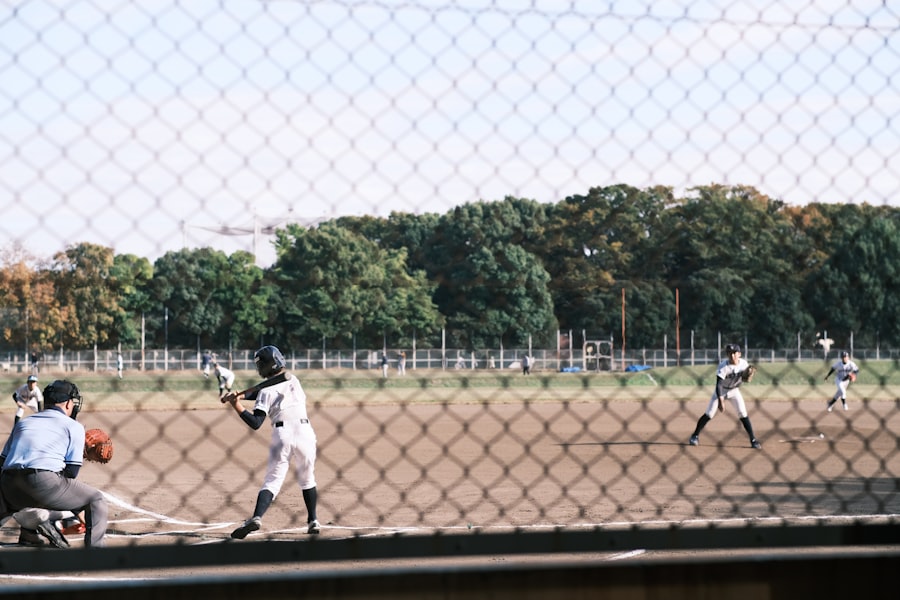Download links
How to install Mastering the Art of Softball: Tips for Success APK?
1. Tap the downloaded Mastering the Art of Softball: Tips for Success APK file.
2. Touch install.
3. Follow the steps on the screen.
Description
Softball is a dynamic and engaging sport that has captivated players and fans alike since its inception in the late 19th century. It is played on a diamond-shaped field, similar to baseball, but with some key differences that set it apart. The game typically features two teams of nine players each, who take turns batting and fielding.
The objective is to score runs by hitting a pitched ball and successfully reaching a series of bases arranged in a diamond shape. The game can be played in various formats, including fast-pitch and slow-pitch, each with its own set of rules and playing styles. The equipment used in softball is also distinct.
Players utilize a larger ball than that used in baseball, which is typically 30.5 centimeters in circumference for fast-pitch and 23 centimeters for slow-pitch. Bats are generally made from aluminum or composite materials, designed to maximize performance while adhering to league regulations. The field dimensions vary depending on the level of play, but the distance from the pitcher’s mound to home plate is usually 43 feet in fast-pitch and 50 feet in slow-pitch.
Understanding these fundamental aspects of the game is crucial for anyone looking to delve deeper into the world of softball.
Key Takeaways
- Softball is a team sport similar to baseball, with a few key differences in rules and equipment.
- Essential skills for success in softball include hand-eye coordination, agility, and communication with teammates.
- Mastering the fundamentals of hitting involves proper stance, grip, and timing, as well as understanding different types of pitches.
- Perfecting fielding and throwing technique requires practice, focus, and understanding of defensive positioning.
- Improving pitching skills involves mastering different types of pitches, developing accuracy, and understanding the mental aspect of pitching.
Developing Essential Skills for Success
To excel in softball, players must cultivate a diverse set of skills that encompass both offensive and defensive play. One of the most critical skills is hand-eye coordination, which is essential for making contact with the ball when batting and for catching it when fielding. Drills that focus on tracking the ball’s trajectory can significantly enhance this ability.
For instance, players can practice hitting off a tee or using a pitching machine to develop their timing and precision. Additionally, engaging in partner drills where one player tosses the ball underhand while the other practices catching can help improve reflexes and coordination. Another vital skill is communication on the field.
Softball is a team sport that requires players to work together seamlessly. Effective communication can prevent errors and ensure that everyone is aware of their responsibilities during plays. Players should practice calling for the ball when fielding and develop signals for coordinating plays, such as double plays or cut-offs.
This aspect of teamwork not only enhances individual performance but also fosters a sense of camaraderie among teammates, which is essential for success in any competitive environment.
Mastering the Fundamentals of Hitting

Hitting is often regarded as one of the most challenging aspects of softball, requiring a combination of technique, timing, and mental focus. To master hitting, players must first understand their stance and grip on the bat. A balanced stance allows for better weight distribution and power generation during the swing.
Players should experiment with their foot positioning and bat angle to find what feels most comfortable while still being effective. A common approach is to keep the feet shoulder-width apart, with knees slightly bent to maintain an athletic posture. Timing is another critical component of successful hitting.
Players must learn to recognize different pitch types—such as fastballs, curveballs, and change-ups—and adjust their swing accordingly. Practicing with live pitching or using a pitching machine can help players develop their timing skills. Additionally, mental preparation plays a significant role in hitting; players should visualize their swings and focus on their approach before stepping into the batter’s box.
This mental rehearsal can enhance confidence and improve overall performance during games.
Perfecting Your Fielding and Throwing Technique
| Technique | Metrics |
|---|---|
| Catching | Success rate, Errors |
| Throwing | Accuracy, Speed |
| Footwork | Efficiency, Agility |
| Positioning | Readiness, Anticipation |
Fielding is an integral part of softball that requires agility, quick reflexes, and precise technique. Players must be adept at fielding ground balls, fly balls, and line drives while maintaining proper body positioning. When fielding ground balls, players should adopt an athletic stance with their knees bent and glove low to the ground.
As the ball approaches, they should move their feet to get into position, using two hands to secure the ball for maximum control. Practicing various fielding drills can help players become more comfortable with different types of batted balls. Throwing technique is equally important in softball, as accurate throws can prevent runs from scoring and turn potential errors into outs.
Players should focus on their grip, arm motion, and follow-through when throwing. A common method involves holding the ball with the index and middle fingers across the seams while using the thumb for support underneath. The throwing motion should be fluid, starting from the shoulder and following through towards the target.
Regular practice with a partner or against a wall can help reinforce proper throwing mechanics and improve accuracy over time.
Improving Your Pitching Skills
Pitching is often considered one of the most specialized skills in softball, requiring a unique blend of strength, technique, and strategy. Fast-pitch softball pitchers must develop a variety of pitches to keep batters guessing, including fastballs, change-ups, curves, and rise balls. Each pitch requires different grips and arm motions; for instance, a rise ball is thrown with an upward motion while maintaining backspin to create lift.
Mastery of these pitches comes from consistent practice and understanding how to read batters’ tendencies. In addition to pitch variety, pitchers must also focus on their mental game. Developing a strong mental approach can help pitchers remain composed under pressure and make strategic decisions during games.
Visualization techniques can be beneficial; pitchers should imagine themselves executing perfect pitches in various game scenarios. Furthermore, understanding the opposing team’s strengths and weaknesses allows pitchers to tailor their approach accordingly, increasing their chances of success on the mound.
Enhancing Your Base Running Abilities

Base running is a crucial aspect of softball that can significantly impact a team’s offensive performance. Effective base running involves not only speed but also smart decision-making regarding when to advance or hold back on the bases. Players should practice their initial steps out of the batter’s box to maximize their chances of reaching first base safely after hitting the ball.
Additionally, understanding base running signals from coaches is vital for making informed decisions during games. Players should familiarize themselves with common signals indicating whether to steal a base or hold their position.
Practicing situational awareness—such as knowing how many outs there are or where the ball is hit—can also enhance base running skills. By developing these abilities, players can become more effective on the bases, contributing to their team’s overall success.
Mental Preparation and Strategy
The mental aspect of softball is often overlooked but plays a significant role in a player’s performance on the field. Mental preparation involves developing focus, confidence, and resilience—qualities that can help athletes navigate the pressures of competition. Visualization techniques are particularly effective; players can mentally rehearse their performances before games or practice sessions to build confidence in their abilities.
Strategic thinking is also essential in softball; players must be able to read situations quickly and make decisions that benefit their team.
Coaches often emphasize situational awareness during practice sessions, encouraging players to think critically about their roles within various game scenarios.
By fostering a strong mental game alongside physical skills, players can elevate their overall performance.
Tips for Maintaining Physical Fitness and Injury Prevention
Maintaining physical fitness is crucial for softball players who want to perform at their best throughout the season. A well-rounded fitness regimen should include strength training, cardiovascular conditioning, flexibility exercises, and sport-specific drills. Strength training helps build muscle endurance necessary for throwing power and batting strength; exercises like squats, lunges, and core workouts are particularly beneficial for softball athletes.
Injury prevention is equally important; players should prioritize proper warm-up routines before practices and games to prepare their bodies for physical exertion. Stretching exercises targeting major muscle groups can enhance flexibility and reduce the risk of strains or sprains during play. Additionally, players should pay attention to any signs of discomfort or fatigue; addressing these issues early can prevent more serious injuries down the line.
By committing to a comprehensive fitness plan that emphasizes both performance enhancement and injury prevention, softball players can enjoy a successful and healthy season on the field.
FAQs
What is softball?
Softball is a bat-and-ball sport that is similar to baseball. It is played on a smaller field and with a larger ball.
How is softball played?
Softball is played between two teams of nine players each. The game consists of innings, with each team taking turns to bat and field.
What are the basic rules of softball?
The basic rules of softball include pitching the ball underhand, hitting the ball with a bat, running the bases, and fielding to get the opposing players out.
What equipment is used in softball?
The equipment used in softball includes a bat, a ball, gloves for fielding, helmets for batting, and protective gear for the catcher.
What are the different types of softball?
There are two main types of softball: fastpitch and slowpitch. Fastpitch softball is played with a larger ball and faster pitching, while slowpitch softball is played with a smaller ball and slower pitching.
What are the health benefits of playing softball?
Playing softball can help improve cardiovascular health, strength, agility, and hand-eye coordination. It also promotes teamwork and social interaction.





